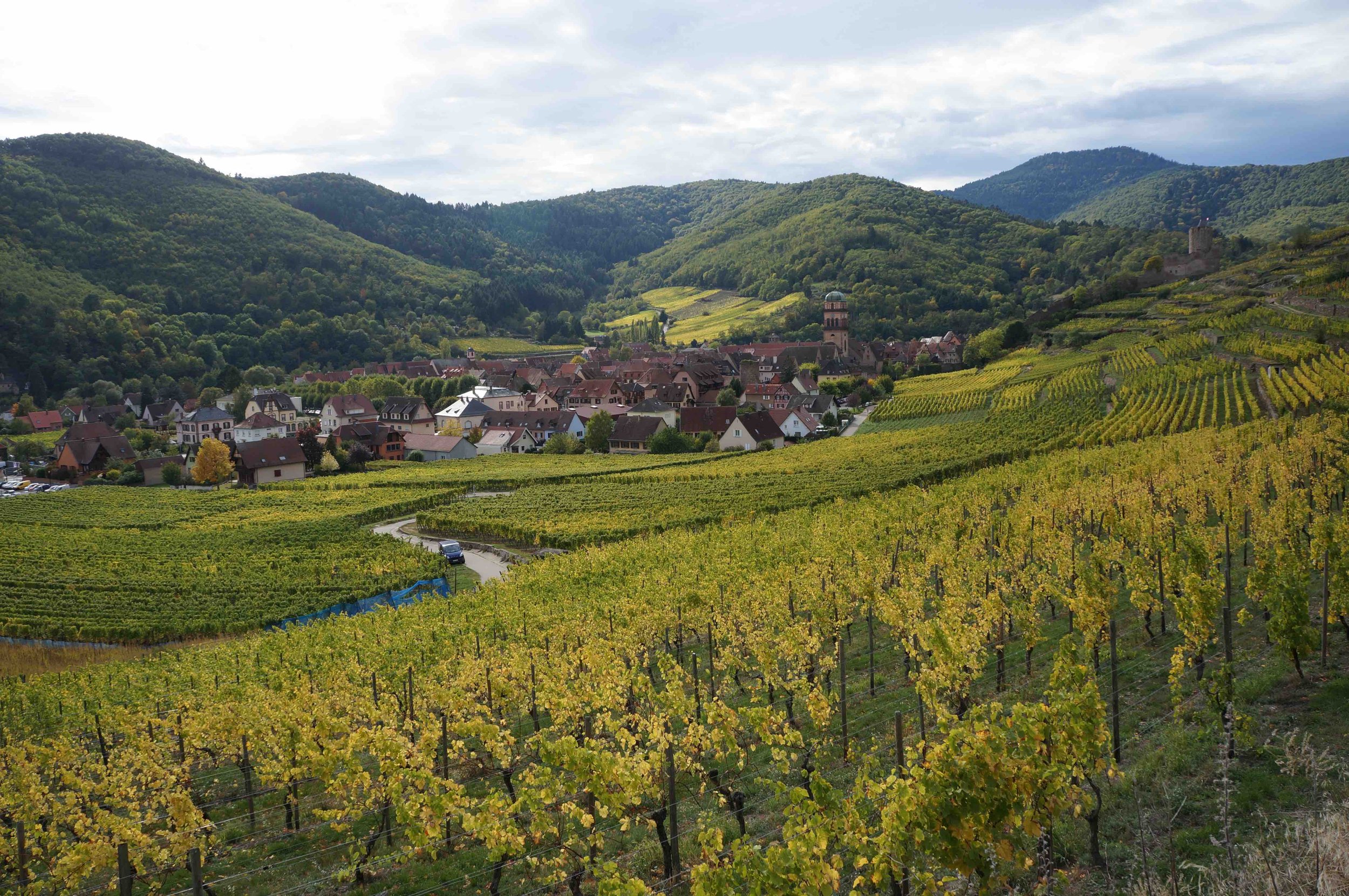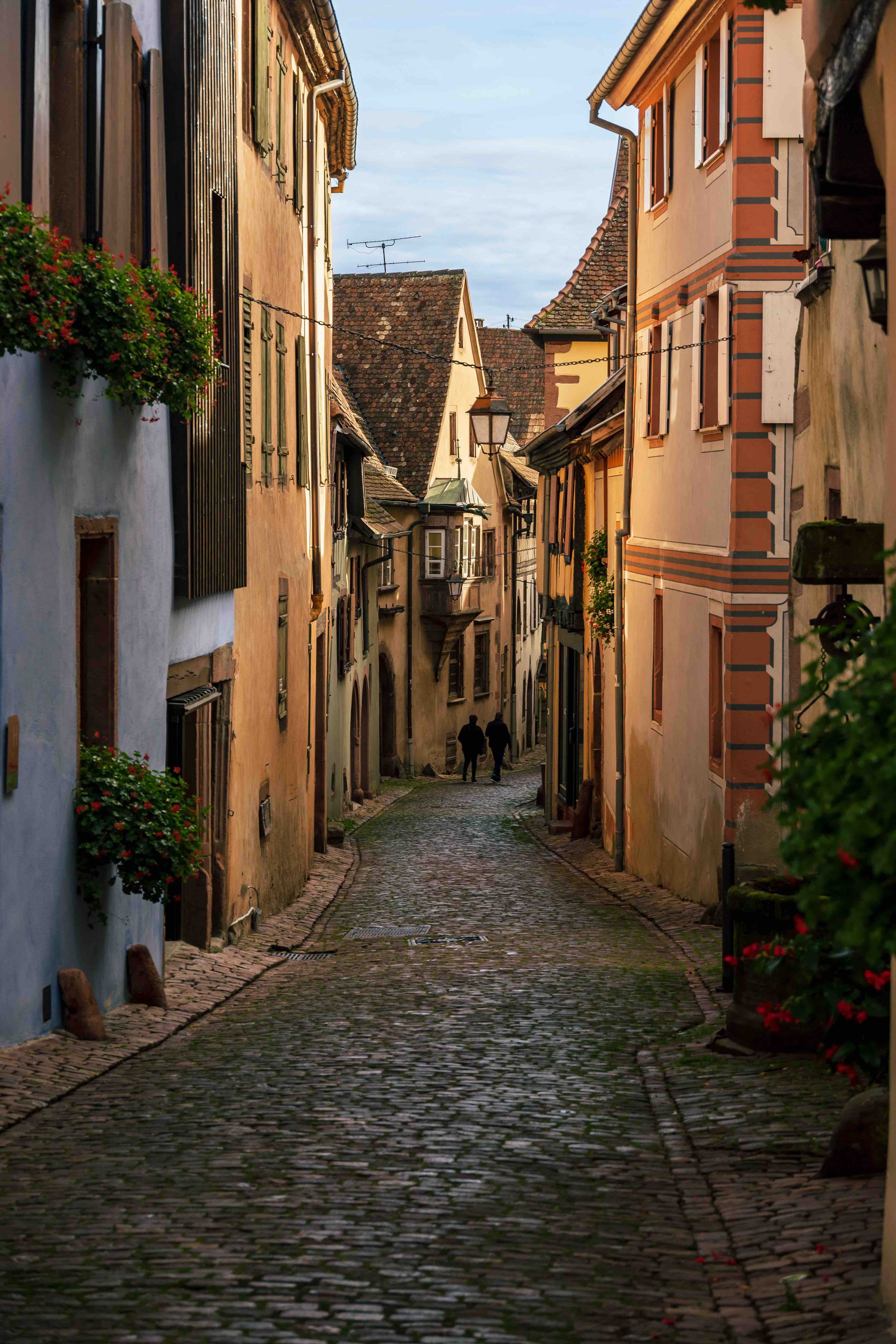Roam Guide / Alsace Region of France
Growing up, when the school holidays rolled around, you could find our family of six packed up in our suburban traveling the US, sightseeing as much as possible. A love for adventure and exploring this world is one of the greatest gifts my dad gave me. In college, I spent J-term studying in Australia as well as completing a Semester at Sea; all of which further instilled my love of travel. Today, I live in Edina, Minnesota with my husband, David, our two young daughters and a six week old baby boy. In my free time, I continue to explore this crazy beautiful world of ours. I’ll use any excuse (just ask my husband) to book a trip and check somewhere new off my ever growing bucket list. - Heidi Daly
Where are we talking about visiting?
Alsace Region, FranceThe “Alsace” region of France is located in the Northeastern part of the county with borders at both Switzerland and Germany. This enchanting and historic province is tucked between the Vosges mountain range and the west bank of the Rhine river. We visited the cities of Colmar, Kaysersberg, Riquewihr, Eguisheim and Strasbourg.
Rtip: Anytime you are traveling abroad we suggest securing travel insurance, contact us directly for a quote.
When should we go to France?
You can visit this part of France year-round but if you prefer to avoid crowds, you should stick to the shoulder season of late April/early May and late September/early October. The Christmas Markets (Christkindelsmärik at Kleber Square) in Colmar are said to be among the best in Europe, when the holiday spirit spectacularly illuminates the entire village. Just plan your trip well in advance and expect a flock of tourists if you’re visiting in December.
How do we get there?
We flew from Minneapolis to Basel, Switzerland, with a stop in Amsterdam. From Basel we hired a driver to take us 40 minutes into Colmar. Alternatively you can also take the train from the airport, which is less expensive and equally convenient.
Where did you stay?
We hunkered down in Colmar for four days before heading to Saint-Rémy-de-Provence. We stayed at the cutest little place called Le Petit Bijou for the remainder of our trip. In Colmar we stayed at Hôtel Le Maréchal, a little boutique property, central to the La Petite Venise area. We also considered La Maison de Tetes, but ultimately decided against it because of cost. Colmar was the perfect home base for us and easy to get in and out of by train. Most people opt to stay a little further north in Strasbourg, but I loved the feel of a small village. Strasbourg is just a bit larger, so if you want a bustling city with access to more activities, then Strasbourg might fit your preferences well. At nearly 7 months pregnant, I certainly wasn’t looking for nightlife. To offer a third option, it would have been completely feasible to have stayed in the smaller nearby village of Kaysersberg, and if I could do it again, I would have looked into that as well.
What should we do in the Alsace Region of France?
Start in Colmar,This fairytale village is best seen with no agenda. Grab a coffee and roam the labyrinth of cobblestone streets. Colmar is filled with charming boutiques, where you can find artisan bake-ware and handicrafts like wooden toys. To sample local delicacies like muenster cheese and traditional Alsatian biscuits, pop into the shops around Petite Venise. Petite Venise (Little Venice); as the name suggests, is tiny but a must do in Colmar. If you’re more of a planner you can download this amazing city map ahead of time to organize a self guided tour of the village. If I was to suggest a few favorites I’d tell you to start inside Petite Venise at The Fisherman’s Quay, a picturesque waterfront district once home to the town’s original fish mongers. Then take a short walk to the historic Maison des Tetes which dates back to the 16th century and is aptly named, the House of Heads. It’s hard to miss since it’s adorned with over 100 sculptured faces. Strolling the streets on our own time was absolutely lovely, but the quintessential thing to do in Colmar is to take in the village from the water. Canal tours are offered in a flat bottom boat and pass by the traditional covered market. Even if you don’t enjoy a boat tour you should grab dinner on the canal. Just make your dining reservations in advance. Every place is surprisingly booked out.
“I couldn't help but be mesmerized by the varied storybook houses and their intricate details”
RSommSays that Colmar is the capital of the Alsace wine region, surrounded by vineyards. You can easily arrange tastings in the center of town or at nearby vineyards. Varietals in this region include Riesling, Gewürztraminer, Muscat and Pinot Gris as well as the local sparkling wine, Crémant d’Alsace. If you are into wine you might consider taking the time to explore the Alsatian Wine Route, specific wineries to note include, Domaine Saint-Remy, Pierre Frick, Domaine Zind-Humbrecht, Domaine Bott-Geyl (top choice for thanksgiving dinner) and Helfrich. Consider booking a private Alsace wine route tour out of Colmar or Strasbourg.
We booked a formal tour guide through Travel France with the help of The Travel Architects to explore the villages of Kaysersberg, Riquewihr and Eguisheim. The best part about hiring a guide was the vast amount of knowledge we captured as he navigated the villages. That said, an independent visit is completely doable. There is a bus system that can take you from village to village, or you can rent bikes to explore on your own. Alternatively if you want some company you can schedule a ride with a group. The nice thing about going it on your own is that you control your speed with freedom to deviate from the plan.
I felt like I was walking among real gingerbread houses. Had I worn a flowy skirt I would have been twirling through the town.”
In Kaysersberg, You’ll find the most romantic and walkable hideaway, and you can easily see the entire village in one afternoon. You won’t want to miss the Church of the Holy Cross. Given that it dates back to the 13th century, it's impressive how well maintained it is. The combination of Romanesque and Gothic architecture makes for a visually stunning landmark. We also climbed to the top of the Chateau de Kaysersberg to take in the colorful village below. And we grabbed a delicious lunch at La Winstub de Chambard. We ordered the local foie gras, the onion tarte (which was highly recommended), and the choucroute (sauerkraut), which is an Alsatian recipe for preparing cabbage with sausages and other salted meats and charcuterie. The portion sizes were large so we shared these plates and left without feeling too full.
In Riquewihr, You’ll feel like you are walking through a living museum. This well-preserved medieval town is known for its half-timbered houses, fortified walls, and the cobbled streets that guide you to the infamous Dolder. The Dolder is an elaborate gate built in the 13th century (1291) to protect the city. Right near the Dolder museum, is Restaurant Le Dolder, and if it’s warm out they have an outdoor patio where you can sit and enjoy the sun with a glass of wine or an ice cream. Their menu is Alsatian and had we been hungry, we would have tried a few things off the menu. They are known for “green” choucroute, also called La Riquewihrienne, and a specialty of Riquewihr. Finally if you love Christmas, you must make time to walk through Kathe Wohlfahrt’s Christmas Shop. The magical holiday spirit just oozes from this German icon.
In Eguisheim, You’ll find the cutest flower-clad village with the most magical central square. Make sure to look to the top of the buildings and admire the storks that reside there, their nests are a sight to see. We loved grabbing gelato and just strolling the narrow cobbled paths. Look for the vibrantly colored houses. I’m told each color represents the original homeowners profession, be it butcher, baker or candlestick maker. Eguisheim is a key stop on the Alsatian wine route. I wasn’t able to partake but my sister enjoyed a tasting at Maison Wolfberger near the center of the village.
Strasbourg, This city was the biggest (and busiest) city we visited. We spent an afternoon here but could easily have spent more time. I felt a bit overwhelmed by its size, which made me glad we decided to stay in Colmar. There are cafes at every turn, top notch restaurants and endless shopping.
If shopping isn’t your thing, I would recommend visiting the Strasbourg Cathedral, also known as the Cathedral of Our Lady of Strasbourg. At over 800 years old, it is an absolutely stunning work of Gothic Romanesque architecture, with a spire that reaches nearly 465 feet. Make sure to stop inside around 12:30 to admire the Astronomical clock and watch the 12 Apostles parading before Jesus as the clock crows three times. Across from there is the Musée de l’Oeuvre Notre-Dame which maintains the upkeep of the Cathedral. Head there if you’re keen to learn more about the monument’s history and admire the stained-glass windows. Another option in Strasbourg would be to head to Parc de l’Orangerie for an afternoon picnic. Here you can watch the storks roaming the grounds, or nestled in their massive nests. If you have kids in tow visit the playground or make a stop at the tiny zoo where you will find monkeys, flamingos, swans and more.
What should we eat in the Alsace Region of France?
We stayed in Colmar, so with the exception of a few lunches we primarily enjoyed our meals there. Be sure to indulge in Flammekueche (tarte flambée). It's a local favorite and we loved it. It looks like thin flatbread covered in fromage blanc and thinly sliced onions. Le Soi is famous for it, but plan ahead as you may need a reservation. It's actually the only thing on the menu and I'd say they’ve easily perfected it. My sister also grabbed a glass of Pinot Noir at Le Soi which was light and lovely. Another dining option in Colmar is Wistub Brenner, which sits near Little Venice and The River La Loche, and offers Alsatian food like escargot and choucroute. Grab a seat on the terrace and enjoy the fresh air. If it’s traditional French food you’re after look for Le Quai 21. They change their menu every six weeks so check online before your visit. Our hotel suggested the Duck Foie Gras from Gers, scallops and a simple cheese plate. Colmar is also home to Michelin star, Restaurant JYS. There are just so many options packed into such a small village.
The entire area has a prominent German influence which was most noticeable when ordering lunch -- the portions were meat heavy and extremely large for a mid-day meal. You should also know that that restaurant operating times are limited, especially in the smaller villages. Many don’t open for dinner until 6:30 or 7 p.m. and breakfast is rarely served before 8 a.m.
We know there is great wine in this region but where can we enjoy a good cup of coffee?
You can find “un petit noir” and a croissant at any number of places in Alsace, but in Colmar I loved, Boulangerie Patisserie Kempf, Pâtisserie Gilg, and Poulaillon. In fact, the array of desserts at Pâtisserie Gilg may seem too pretty to eat. The buttery goodness of their croissants and the moist freshness of their macaroons are a sight. Their choux dough eclairs are filled with cream and topped with chocolate icing -- an absolute “must try” if you have a sweet tooth! Word to the wise however, the bakery cafes in Colmar don't open especially early. Frankly, some weren't even open at 7 a.m., so take that in to consideration if you find yourself jet-lagged wandering the streets really early. We learned that one the hard way.
“If you find me in France, you'll find me with a chocolate croissant. It is not something I eat at home so I love indulging when I can.”
What is one can’t miss item on your itinerary?
Do I have to pick just one?! As far as villages are concerned, I wouldn’t miss Colmar or Kaysersberg. For an activity, you really must find time to roam the streets with no agenda.
Tell us what would you’d differently next time?
I would have liked to bike from village to village. You can even walk between some of them if you have the time, and the 7km route between Colmar and Eguisheim is actually part of the Alsace wine route.
What should we know before traveling to France?
The Alsatians have changed nationalities at least four times switching sovereignty between France and Germany. Currently, they are under French leadership and they speak mostly French and Alsatian.
Given the region’s history, you can understand why there is so much French and German influence throughout each of the villages. I also noticed more of a language barrier in the Alsace region than other places I have traveled. As an English speaker I found communication difficult at times.
Where can we do a little shopping in Alsace?
Strasbourg is the best place to shop, shop, shop. Take the opportunity to browse during the day, but be sure to come back at night to see the lights filter through the streets. A couple notable shoppes worth mentioning in the area would be, Marie-Laure Boutique which is a cute home goods shop full of fun trinkets and vintage goodies. As well as Søstrene Greene which is a little gift shop with a limited stock of housewares, holiday and decor.
If you are looking for a centralized area of options (like a mall), head to L’Aubette shopping arcade and Galeries Lafayette, both located around Place Kleber. If you are after boutique shops, the Rue des Orfèvres is the most picturesque shopping street in Strasbourg, located right in the Le Carré d'Or shopping district / neighborhood. Another street to check out is, Rue de la Mésange which filled with high end designer goods and fun to browse out even if you don’t plan on buying anything.
What can we bring back with us?
Gingerbread anything, it’s an Alsatian specialty. Mireille Oster Pain d'Epices in Strasbourg is filled with tasty treats and a variety of handmade Gingerbreads that are easy to bring home to friends and family. It’s geared towards the holiday season but worthy of a visit year-round. I’d also suggest you bring back some Alsatian wine, of course! The wine shop on the ground floor of The Pfister House is a great place to make a purchase.
What should we take on the trip?
Pack casual, for a comfortable street style. I prefer taking lightweight dresses and sweaters for layering. A couple basic t-shirts, a few casual tank tops and you’re set. Nice walking sneakers are a must, and don’t forget a trusty pair of sunglasses. In my opinion, you can never go wrong with an oversized scarf for plane and train rides, which can get chilly. My must have for this trip were packing compression cubes.
“I managed to pack 11 days’ worth of clothes and toiletries in a carry-on thanks to these!”







